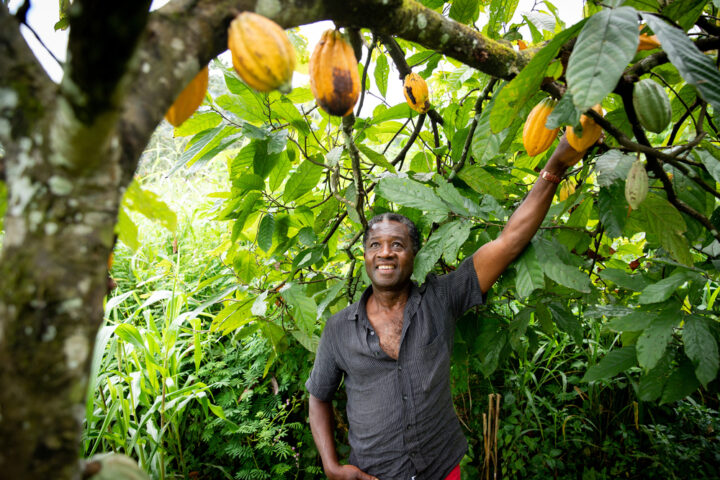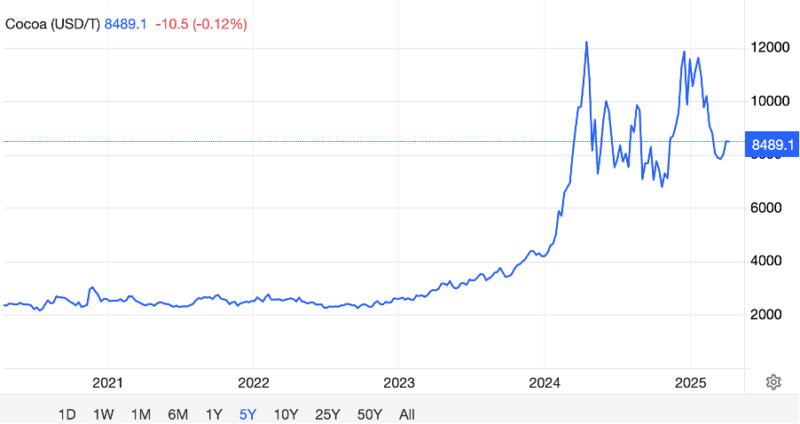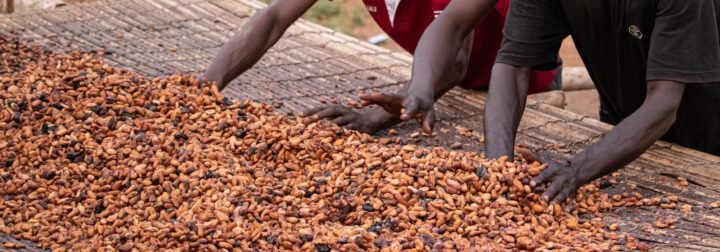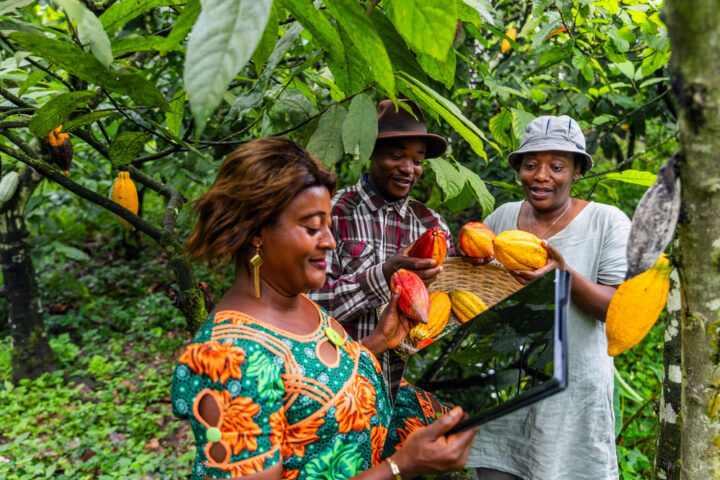Climate impacts on cocoa
Average price per kilo of cocoa beans imported into the UK has risen 32% over the last three years.
Last updated:
The UK imports two fifths of its food, growing the rest at home. However, climate impacts are ramping up everywhere, meaning no part of our food system is safe.
This is an update to a 2023 analysis with a special focus on cocoa, a highly sensitive crop that is only grown at commercial scale in a handful of nations globally. Otherwise known as the ‘cocoa belt’ that wraps the equator, these already hot countries are extremely vulnerable to temperature rise and the resultant changes to precipitation.This is an update to that 2023 analysis with a special focus on cocoa, a highly sensitive crop that is only grown at commercial scale in a handful of nations globally. Otherwise known as the ‘cocoa belt’ that wraps the equator, these already hot countries are extremely vulnerable to temperature rise and the resultant changes to precipitation.
Cocoa production
In 2024, the UK imported 57 million kilograms of cocoa beans worth £160 million directly from producers. All of them were low climate readiness countries, which means they are highly exposed to climate impacts but also lack the resources to respond and adapt.
According to data from the UN Food and Agriculture Organisation (FAO), almost all cocoa globally (99.9%) is grown in low climate readiness countries. This is because cocoa is a highly sensitive plant that is only grown in the ‘cocoa belt’ around the equator. Countries in this region tend to be developing nations with low climate readiness.
Therefore, any cocoa beans that come to us from countries with higher levels of climate readiness – like The Netherlands, which is a major port – will have also been grown in the vulnerable cocoa belt; they’ve just been imported via a third-party country. The same goes for all chocolate products. Whether we’re buying Swiss, Belgian or French chocolate, these suppliers will have got their raw ingredient from the same few countries that supply cocoa beans globally.
Ivory Coast and Ghana are the world’s top suppliers, producing more than half of cocoa globally. Ivory Coast was the UK’s top supplier last year, accounting for 84% (48 million kilograms worth £135 million) of the cocoa beans we imported.
West Africa has been pummelled by climate impacts over the past few years. There was extreme rainfall in 2023, with total precipitation more than double the 30-year average for the time of year. This caused an outbreak of black pod disease, with cocoa plants rotting in the wet conditions. This was followed by a drought in early 2024 typical of El Niño, the warm phase of the El Niño Southern Oscillation (ENSO), a natural climate phenomenon. However, climate change is interacting with El Niño to drive even higher temperatures and more extreme weather. In March 2024, West Africa was then hit with an extreme humid heatwave, which scientists at the World Weather Attribution (WWA) said was made 4°C hotter and 10 times more likely by climate change.
In short, West African farmers went from having far too much rain to not enough, all under oppressively hot temperatures, which affected the sowing, growing and harvesting of cocoa crops.
But they aren’t the only ones affected. A report by charity Christian Aid highlights how climate change is also impacting cocoa farmers in South America, like in Brazil and Ecuador, as well as in Asian countries like Indonesia.

Impact on consumers
Like most other commodities, cocoa is traded on international markets, and the extreme weather events of the past few years have caused its price to skyrocket. On 15 April 2024, it hit a record high of around $12,200 per tonne. This was almost 19 times more expensive than oil, weight-for-weight, on the same date. Today (mid-April 2025), it’s trading at around $8,500 per tonne, which is over three times more expensive than the same time in 2022 (before the recent extreme weather, when prices were relatively stable).

Source: Trading Economics cocoa page, https://tradingeconomics.com/commodity/cocoa, accessed 10 April 2025 at 12:51
As a result of these high prices, the quantity of cocoa beans the UK has imported directly from producers has gone down over the past three years.
- In 2022, we imported 63 million kilograms worth £134 million.
- In 2023, we imported 58 million kilograms worth £127 million.
- In 2024, we imported 57 million kilograms worth £160 million.
This means that imports of cocoa beans to the UK have fallen by 10% since 2022, while the total cost has risen by around 20%. The average price per kilo has gone up by a third (32%), meaning the UK is paying more for less cocoa.
This has hit British chocolatiers hard, with reports of several struggling around Valentine’s Day (here, here), and is feeding through to consumers. When the Office for National Statistics (ONS) released its monthly inflation figures in March 2025, overall inflation had come down, but food price inflation had held stubbornly at 3.1%. For chocolate specifically, it had gone up from around 14% the previous month to almost 17%. In year-to-date (YTD) inflation, that’s up from 8.9% at the same time last year.
Cocoa isn’t the only commodity that bears the fingerprints of climate change. Research has shown that climate change added £360 to the average household food bill across 2022 and 2023. We have seen much more extreme weather since then, meaning this number is likely to have risen.

Impact on farmers
Extreme weather driven by climate change and El Niño threatens farmers’ livelihoods. Heat, drought and above-average rainfall all affect the planting and sowing of crops, irrigation through the growing period, and harvest. They hit the stability of production and therefore agricultural productivity. Not only does this affect the crops themselves – driving shortages, squeezing supplies of cocoa for global markets and sharply raising prices – but it also hits the people that produce the cocoa.
Reduced productivity drastically reduces farmer incomes, but extreme weather also threatens their health. Over a quarter of the global working age population – some 1.6 billion people – were estimated to work outdoors in 2023; a proportion that was higher still (over 30% of the working age population) in the poorest and least developed countries. As climate change drove temperatures up, heat exposure caused losses of more than half a trillion (512 billion) potential working hours, with two thirds (63%) of these occurring in the agricultural sector.
Despite the debilitating effects of extreme heat on the body – like the fact that the risk of a fatal heart attack doubles in a heatwave, and that heatwaves are associated with almost a 12% increase in mortality risk from cardiovascular diseases more broadly – not everyone threatened by heat exposure will stop working when temperatures become dangerous. Given that food production operates to very tight margins, and cocoa is produced in some of the poorest nations in the world, many will either choose or be forced to work on, risking their health and even their lives.
Financial uncertainty and dangerous conditions also create mental health pressures on farmers, including a form of 'ecological grief’ that comes from the loss of crops and traditional farming methods as the sector changes. All of this can drive people to leave farming and seek more stable jobs in urban areas instead.

